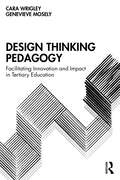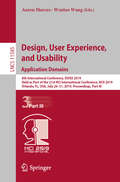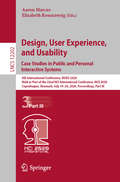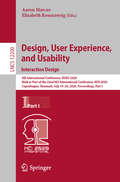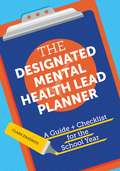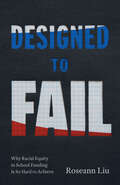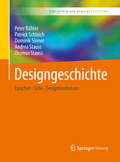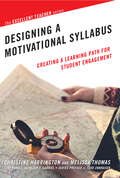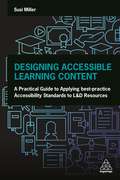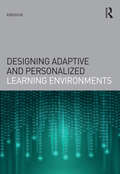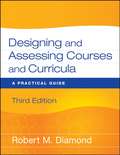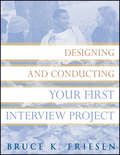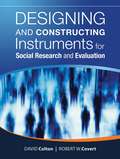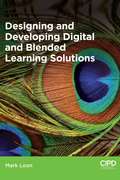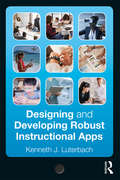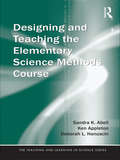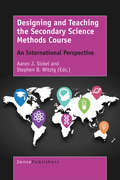- Table View
- List View
Design Thinking Pedagogy: Facilitating Innovation and Impact in Tertiary Education
by Cara Wrigley Genevieve MoselyThe problems facing society today are complex, multifaceted, and require crossing multiple disciplinary boundaries. As such, these problems call for interdisciplinary collaboration, including new and different combinations of skills and knowledge. Currently, tertiary education providers are not well-positioned to develop these interdisciplinary capabilities at a rate commensurate with the speed of contemporary change. This book places design thinking as the catalyst to create change in the tertiary education sector and to build interdisciplinary skill sets that are required for the graduate of the future. By presenting a series of case studies and drawing on global experts in the field, this book investigates pedagogical approaches, disciplinary facilitation practice, curriculum integration, and a framework for understanding design thinking pedagogy within tertiary education. Focusing on how educational institutions can produce innovative graduates with the ability to traverse disciplinary constraints, this book will be essential reading for research students, academics, and industry practitioners.
Design, User Experience, and Usability. Application Domains: 8th International Conference, DUXU 2019, Held as Part of the 21st HCI International Conference, HCII 2019, Orlando, FL, USA, July 26–31, 2019, Proceedings, Part III (Lecture Notes in Computer Science #11585)
by Aaron Marcus Wentao WangThe four-volume set LNCS 11583, 11584, 11585, and 11586 constitutes the proceedings of the 8th International Conference on Design, User Experience, and Usability, DUXU 2019, held as part of the 21st International Conference, HCI International 2019, which took place in Orlando, FL, USA, in July 2019.The total of 1274 papers and 209 posters included in the 35 HCII 2019 proceedings volumes was carefully reviewed and selected from 5029 submissions.DUXU 2019 includes a total of 167 regular papers, organized in the following topical sections: design philosophy; design theories, methods, and tools; user requirements, preferences emotions and personality; visual DUXU; DUXU for novel interaction techniques and devices; DUXU and robots; DUXU for AI and AI for DUXU; dialogue, narrative, storytelling; DUXU for automated driving, transport, sustainability and smart cities; DUXU for cultural heritage; DUXU for well-being; DUXU for learning; user experience evaluation methods and tools; DUXU practice; DUXU case studies.
Design, User Experience, and Usability. Case Studies in Public and Personal Interactive Systems: 9th International Conference, DUXU 2020, Held as Part of the 22nd HCI International Conference, HCII 2020, Copenhagen, Denmark, July 19–24, 2020, Proceedings, Part III (Lecture Notes in Computer Science #12202)
by Aaron Marcus Elizabeth RosenzweigThis book constitutes the refereed proceedings of the 9th International Conference on Design, User Experience, and Usability, DUXU 2020, held as part of the 22nd International Conference on Human-Computer Interaction, HCII 2020, in Copenhagen, Denmark, in July 2020. The conference was held virtually due to the COVID-19 pandemic. From a total of 6326 submissions, a total of 1439 papers and 238 posters has been accepted for publication in the HCII 2020 proceedings. The 51 papers included in this volume were organized in topical sections on interactions in public, urban and rural contexts; UX design for health and well-being; DUXU for creativity, learning and collaboration; DUXU for culture and tourism.
Design, User Experience, and Usability. Interaction Design: 9th International Conference, DUXU 2020, Held as Part of the 22nd HCI International Conference, HCII 2020, Copenhagen, Denmark, July 19–24, 2020, Proceedings, Part I (Lecture Notes in Computer Science #12200)
by Aaron Marcus Elizabeth RosenzweigThis book constitutes the refereed proceedings of the 9th International Conference on Design, User Experience, and Usability, DUXU 2020, held as part of the 22nd International Conference on Human-Computer Interaction, HCII 2020, in Copenhagen, Denmark, in July 2020. The conference was held virtually due to the COVID-19 pandemic.From a total of 6326 submissions, a total of 1439 papers and 238 posters has been accepted for publication in the HCII 2020 proceedings. The 40 papers included in this volume were organized in topical sections on UX design methods, tools and guidelines, interaction design and information visualization, and emotional design.
The Designated Mental Health Lead Planner: A Guide and Checklist for the School Year
by Clare ErasmusThis planner provides detailed guidance on what a Designated Mental Health Lead needs to do, when they need to do it, and how they can achieve the best results. It gives a clear focus and checklist for each week, including spaces to add your own to-do list, and encourages reflection on the outcomes and impact of your actions on pupils' attainment and wellbeing. It also encourages a focus on your own development and self-care, with space to record what you are currently reading or listening to and one thing you are grateful for that week.In addition to the termly and weekly plans, the book provides short briefs on key aspects of the role, including how to work effectively with teachers, the HR team, the DSL, governors, the pastoral team, Mental Health Support Teams and parents. It is an invaluable resource for all DMHLs tackling the 39 academic weeks.
Designed to Fail: Why Racial Equity in School Funding Is So Hard to Achieve
by Roseann LiuA provocative examination of how systemic racism in education funding is sustained. For people who care about urban school districts like Philadelphia’s, addressing the challenges that these schools face often boils down to the need for more money. But why are urban districts that serve Black and Brown students still so perennially underfunded compared to majority-white ones? Why is racial equity in school funding so hard to achieve? In Designed to Fail, Roseann Liu provides an inside look at the Pennsylvania state legislature and campaigns for fair funding to show how those responsible for the distribution of school funding work to maintain the privileges of majority-white school districts. Liu analyzes how colorblind policies, political structures, and the maintenance of the status quo by people in power perpetuate wide and deepening racial disparities in education funding. Taking a lesson from community organizers fighting for a racially equitable school funding system, Liu’s work is a bold call to address structural racism at the root and organize from a place of abundant justice.
Designgeschichte: Epochen – Stile – Designtendenzen (Bibliothek der Mediengestaltung)
by Peter Bühler Patrick Schlaich Dominik Sinner Andrea Stauss Thomas StaussTauchen Sie mit diesem Buch tief in die Designgeschichte ein Sie sind auf der Suche nach einem soliden Nachschlagewerk über die Designgeschichte? Sie möchten Ihr Verständnis für die Entwicklungshintergründe der Stile und Epochen sensibilisieren? Dann darf dieser Band aus der „Bibliothek der Mediengestaltung“ in Ihrem Bücherregal nicht fehlen. Die Autoren nehmen Sie mit auf eine Zeitreise durch wichtige Kunstepochen - vom vorgeschichtlichen Design bis heute. Erfahren Sie mehr über: • Gotik • Barock • Biedermeier • Arts-and-Crafts-Bewegung • Bauhaus • Pop-Design Dieses Buch vermittelt Grundwissen und -begriffen und zeigt Ihnen, wie Sie Designtendenzen und epochentypische Merkmale bestimmen, die unsere Gesellschaft zum Teil bis heute prägen. Ein hilfreiches Nachschlagewerk für viele Zielgruppen Mit vielen Aufgaben und Musterlösungen am Ende der Kapitel überprüfen Sie Ihren Lernfortschritt. Dadurch vereint dieses Werk nachhaltig Theorie und Praxis und bereitet Sie optimal auf Prüfungen in Studiengängen und Ausbildungen rund um die gängigen Print- und Digitalmedien vor.
Designing a Motivational Syllabus: Creating a Learning Path for Student Engagement
by Christine Harrington Melissa ThomasA thoughtfully constructed syllabus can be transformative for your students’ learning, communicating the path they can take to succeed. This book demonstrates how, rather than being a mundane document to convey policies, you can construct your syllabus to be a motivating resource that conveys a clear sense of your course’s learning goals, how students can achieve those goals, and makes evident your teaching philosophy and why you have adopted the teaching strategies you will use, such as discussion or group activities. Developing or revising a syllabus also presents you with a perfect opportunity to review the learning possibilities for the semester. Well-designed, it can help you stay focused on achieving the learning outcomes, as well as determine if the class is on track and whether adjustments to the schedule are needed. The authors show how, by adopting a welcoming tone and clearly stating learning outcomes, your syllabus can engage students by explaining the relevance of your course to their studies, create an all-important positive first impression of you as an instructor, and guide students through the resources you will be using, the assignments ahead, as well as clear guidance on how they will be assessed. Referred to frequently as the course progresses, an effective syllabus will keep students engaged and on task.Christine Harrington and Melissa Thomas lead you through all the elements of a syllabus to help you identify how to present key messages and information about your course, think through the impressions you want to create, and, equally importantly, suggest how you can use layout and elements such as images and charts to make your syllabus visually appealing and easy to navigate.
Designing a Motivational Syllabus: Creating a Learning Path for Student Engagement
by Christine Harrington Melissa ThomasA thoughtfully constructed syllabus can be transformative for your students’ learning, communicating the path they can take to succeed. This book demonstrates how, rather than being a mundane document to convey policies, you can construct your syllabus to be a motivating resource that conveys a clear sense of your course’s learning goals, how students can achieve those goals, and makes evident your teaching philosophy and why you have adopted the teaching strategies you will use, such as discussion or group activities. Developing or revising a syllabus also presents you with a perfect opportunity to review the learning possibilities for the semester. Well-designed, it can help you stay focused on achieving the learning outcomes, as well as determine if the class is on track and whether adjustments to the schedule are needed. The authors show how, by adopting a welcoming tone and clearly stating learning outcomes, your syllabus can engage students by explaining the relevance of your course to their studies, create an all-important positive first impression of you as an instructor, and guide students through the resources you will be using, the assignments ahead, as well as clear guidance on how they will be assessed. Referred to frequently as the course progresses, an effective syllabus will keep students engaged and on task.Christine Harrington and Melissa Thomas lead you through all the elements of a syllabus to help you identify how to present key messages and information about your course, think through the impressions you want to create, and, equally importantly, suggest how you can use layout and elements such as images and charts to make your syllabus visually appealing and easy to navigate.
Designing Accessible Learning Content: A Practical Guide to Applying best-practice Accessibility Standards to L&D Resources
by Susi MillerMaking learning and development (L&D) content inclusive and accessible for everyone is not only a good thing to do, it's the right thing to do. Designing Accessible Learning Content provides evidence-based advice on designing digital learning content that ensures all learners are included and are therefore able to perform to their full potential.This is a practical guide on accessibility for anyone involved in the design, creation, development or testing of online learning content. It provides detailed guidance on how to meet the Web Content Accessibility Guidelines making it essential reading for L&D professionals, instructional designers and course developers who need to comply with legal accessibility requirements. Using the author's 'eLearning Accessibility Framework', Designing Accessible Learning Content demystifies sometimes complex technical accessibility standards and provides an easy to follow contextual framework uniquely designed for learning content created using any authoring tool.This book also demonstrates how creating accessible learning content can improve usability and provide the best possible learning experience for everyone. In addition, it offers essential background information such as a focus on disability, an overview of assistive technology and an exploration of the case for digital accessibility. This guarantees that L&D professionals have the vital background knowledge they need to make sense of accessibility before they begin practically applying the principles. With online checklists, learner case studies, and industry perspectives, Designing Accessible Content is an essential handbook for all L&D professionals seeking to harness the benefits of accessibility in order to improve their learning content for everyone.
Designing Adaptive and Personalized Learning Environments (Interdisciplinary Approaches to Educational Technology)
by KinshukDesigning Adaptive and Personalized Learning Environments provides a theoretically-based yet practical guide to systematic design processes for learning environments that provide automatic customization of learning and instruction. The book consists of four main sections: In "Introduction and Overview," the concepts of adaptivity and personalization are introduced and explored in detail. In "Theoretical Perspectives with Example Applications," various theoretical concepts underlying adaptive and personalized learning are discussed, including cognitive profiling, content-based adaptivity, exploration-based adaptivity, and mobile and ubiquitous settings. In "Practical Perspectives with Example Applications," the implementation process for adaptive and personalized learning environments is described, followed by application in various contexts. In "Validation and Future Trends," various evaluation techniques for validating the efficiency and efficacy of adaptive and personalized learning systems are discussed. This final section concludes with a discussion of emerging trends in adaptive and personalized learning research. Based on cutting-edge research, Designing Adaptive and Personalized Learning Environments is appropriate as a primary textbook for both undergraduate and graduate courses focused on the design of learning systems, and as a secondary textbook for a variety of courses in programs such as educational technology, instructional design, learning sciences, digital literacy, computer based systems, and STEM content fields.
Designing Adaptive and Personalized Learning Environments (Interdisciplinary Approaches to Educational Technology)
by KinshukDesigning Adaptive and Personalized Learning Environments provides a theoretically-based yet practical guide to systematic design processes for learning environments that provide automatic customization of learning and instruction. The book consists of four main sections: In "Introduction and Overview," the concepts of adaptivity and personalization are introduced and explored in detail. In "Theoretical Perspectives with Example Applications," various theoretical concepts underlying adaptive and personalized learning are discussed, including cognitive profiling, content-based adaptivity, exploration-based adaptivity, and mobile and ubiquitous settings. In "Practical Perspectives with Example Applications," the implementation process for adaptive and personalized learning environments is described, followed by application in various contexts. In "Validation and Future Trends," various evaluation techniques for validating the efficiency and efficacy of adaptive and personalized learning systems are discussed. This final section concludes with a discussion of emerging trends in adaptive and personalized learning research. Based on cutting-edge research, Designing Adaptive and Personalized Learning Environments is appropriate as a primary textbook for both undergraduate and graduate courses focused on the design of learning systems, and as a secondary textbook for a variety of courses in programs such as educational technology, instructional design, learning sciences, digital literacy, computer based systems, and STEM content fields.
Designing and Assessing Courses and Curricula: A Practical Guide
by Robert M. DiamondDesigning and Assessing Courses and Curricula reflects the most current knowledge and practice in course and curriculum design and connects this knowledge with the critical task of assessing learning outcomes at both course and curricular levels. This thoroughly revised and expanded third edition of the best-selling book positions course design as a tool for educational change and contains a wealth of new material including new chapters, case examples, and resources.
Designing and Assessing Courses and Curricula: A Practical Guide
by Robert M. DiamondDesigning and Assessing Courses and Curricula reflects the most current knowledge and practice in course and curriculum design and connects this knowledge with the critical task of assessing learning outcomes at both course and curricular levels. This thoroughly revised and expanded third edition of the best-selling book positions course design as a tool for educational change and contains a wealth of new material including new chapters, case examples, and resources.
Designing and Conducting Your First Interview Project (Research Methods for the Social Sciences #17)
by Bruce K. FriesenDesigning and Conducting Your First Interview Project Using a clear, easily followed approach, Designing and Conducting Your First Interview Project helps anyone new to the process develop the skills to conduct the most essential part of social research data collection: the interview. The book also shows how to organize, analyze, and interpret the data. This workbook provides a step-by-step template for a collaborative class experience in social science. Organized according to the steps of the deductive scientific method, it includes essential activities to take place during class after the appropriate chapter has been read. The book begins with the process of choosing a topic and proceeds through hypothesis development, interview data collection, data entry using SPSS, and elementary data analysis. The final chapter includes the formal assignment and instructions to students on how to write about their experiences in a way that will produce an excellent final paper. By selecting the hypothesis, gathering the data, and analyzing the results, students will gain an appreciation for the strengths and potential weaknesses of "knowing" things through doing quantitative social science.
Designing and Conducting Your First Interview Project (Research Methods for the Social Sciences #17)
by Bruce K. FriesenDesigning and Conducting Your First Interview Project Using a clear, easily followed approach, Designing and Conducting Your First Interview Project helps anyone new to the process develop the skills to conduct the most essential part of social research data collection: the interview. The book also shows how to organize, analyze, and interpret the data. This workbook provides a step-by-step template for a collaborative class experience in social science. Organized according to the steps of the deductive scientific method, it includes essential activities to take place during class after the appropriate chapter has been read. The book begins with the process of choosing a topic and proceeds through hypothesis development, interview data collection, data entry using SPSS, and elementary data analysis. The final chapter includes the formal assignment and instructions to students on how to write about their experiences in a way that will produce an excellent final paper. By selecting the hypothesis, gathering the data, and analyzing the results, students will gain an appreciation for the strengths and potential weaknesses of "knowing" things through doing quantitative social science.
Designing and Constructing Instruments for Social Research and Evaluation (Research Methods for the Social Sciences)
by David Colton Robert W. CovertWritten in easy-to-understand language, this important text provides a systematic and commonsense approach to developing instruments for data collection and analysis. This book can be used by both those who are developing instruments for the first time and those who want to hone their skills, including students, agency personnel, program managers, and researchers. This book provides a thorough presentation of instrument construction, from conception to development and pre-testing of items, formatting the instrument, administration, and, finally, data management and presentation of the findings. Throughout the book, the authors emphasize how to create an instrument that will produce trustworthy and accurate data. To that end they have included guidelines for reviewing and revising the questionnaire to enhance validity and reliability. They also show how to work effectively with stakeholders such as instruments designers, decision-makers, agency personnel, clients, and raters or respondents.
Designing and Constructing Instruments for Social Research and Evaluation (Research Methods for the Social Sciences)
by David Colton Robert W. CovertWritten in easy-to-understand language, this important text provides a systematic and commonsense approach to developing instruments for data collection and analysis. This book can be used by both those who are developing instruments for the first time and those who want to hone their skills, including students, agency personnel, program managers, and researchers. This book provides a thorough presentation of instrument construction, from conception to development and pre-testing of items, formatting the instrument, administration, and, finally, data management and presentation of the findings. Throughout the book, the authors emphasize how to create an instrument that will produce trustworthy and accurate data. To that end they have included guidelines for reviewing and revising the questionnaire to enhance validity and reliability. They also show how to work effectively with stakeholders such as instruments designers, decision-makers, agency personnel, clients, and raters or respondents.
Designing and Developing Digital and Blended Learning Solutions
by Mark LoonDesigning and Developing Digital and Blended Learning Solutions is essential reading for anyone studying the Level 5 CIPD L&D module of the same name as well as all learning and development professionals looking to understand the growing role of technology in L&D. Covering both current and emerging learning technologies, this book will help readers assess which technologies are right for their needs. It also covers how to design blended learning solutions, how to develop digital learning content as well as how to evaluate the effectiveness of this digital content. Most importantly, Designing and Developing Digital and Blended Learning Solutions provides guidance on how to implement digital and blended learning solutions including identifying the appropriate platforms and the roles, tools and processes needed to support effective implementation. Full of practical examples and advice, this is an invaluable guide for students and practitioners alike.
Designing and Developing Digital and Blended Learning Solutions
by Mark LoonDesigning and Developing Digital and Blended Learning Solutions is essential reading for anyone studying the Level 5 CIPD L&D module of the same name as well as all learning and development professionals looking to understand the growing role of technology in L&D. Covering both current and emerging learning technologies, this book will help readers assess which technologies are right for their needs. It also covers how to design blended learning solutions, how to develop digital learning content as well as how to evaluate the effectiveness of this digital content. Most importantly, Designing and Developing Digital and Blended Learning Solutions provides guidance on how to implement digital and blended learning solutions including identifying the appropriate platforms and the roles, tools and processes needed to support effective implementation. Full of practical examples and advice, this is an invaluable guide for students and practitioners alike.
Designing and Developing Robust Instructional Apps
by Kenneth J. LuterbachDesigning and Developing Robust Instructional Apps advances the state of instructional app development using three learning paradigms for building knowledge foundations, problem-solving, and experimentation. Drawing on research and development lessons gleaned?from noted educational technologists, time-tested systematic instructional design processes, and results from user experience design, the book considers the planning and specification of instructional apps that blend media (text, images, sound, and moving pictures) and instructional method. Further, for readers with little to no programming experience, introductory treatments of JavaScript and Python, along with data fundamentals and machine learning techniques, offer a guided journey that produces robust instructional apps and?concludes with next steps for advancing the state of instructional app development.
Designing and Developing Robust Instructional Apps
by Kenneth J. LuterbachDesigning and Developing Robust Instructional Apps advances the state of instructional app development using three learning paradigms for building knowledge foundations, problem-solving, and experimentation. Drawing on research and development lessons gleaned?from noted educational technologists, time-tested systematic instructional design processes, and results from user experience design, the book considers the planning and specification of instructional apps that blend media (text, images, sound, and moving pictures) and instructional method. Further, for readers with little to no programming experience, introductory treatments of JavaScript and Python, along with data fundamentals and machine learning techniques, offer a guided journey that produces robust instructional apps and?concludes with next steps for advancing the state of instructional app development.
Designing and Teaching the Elementary Science Methods Course (Teaching and Learning in Science Series)
by Sandra K. Abell Ken Appleton Deborah L. HanuscinWhat do aspiring and practicing elementary science teacher education faculty need to know as they plan and carry out instruction for future elementary science teachers? This scholarly and practical guide for science teacher educators outlines the theory, principles, and strategies needed, and provides classroom examples anchored to those principles. The theoretical and empirical foundations are supported by scholarship in the field, and the practical examples are derived from activities, lessons, and units field-tested in the authors’ elementary science methods courses. Designing and Teaching the Elementary Science Methods Course is grounded in the theoretical framework of pedagogical content knowledge (PCK), which describes how teachers transform subject matter knowledge into viable instruction in their discipline. Chapters on science methods students as learners, the science methods course curriculum, instructional strategies, methods course assessment, and the field experience help readers develop their PCK for teaching prospective elementary science teachers. "Activities that Work" and "Tools for Teaching the Methods Course" provide useful examples for putting this knowledge into action in the elementary science methods course.
Designing and Teaching the Elementary Science Methods Course (Teaching and Learning in Science Series)
by Sandra K. Abell Ken Appleton Deborah L. HanuscinWhat do aspiring and practicing elementary science teacher education faculty need to know as they plan and carry out instruction for future elementary science teachers? This scholarly and practical guide for science teacher educators outlines the theory, principles, and strategies needed, and provides classroom examples anchored to those principles. The theoretical and empirical foundations are supported by scholarship in the field, and the practical examples are derived from activities, lessons, and units field-tested in the authors’ elementary science methods courses. Designing and Teaching the Elementary Science Methods Course is grounded in the theoretical framework of pedagogical content knowledge (PCK), which describes how teachers transform subject matter knowledge into viable instruction in their discipline. Chapters on science methods students as learners, the science methods course curriculum, instructional strategies, methods course assessment, and the field experience help readers develop their PCK for teaching prospective elementary science teachers. "Activities that Work" and "Tools for Teaching the Methods Course" provide useful examples for putting this knowledge into action in the elementary science methods course.
Designing and Teaching the Secondary Science Methods Course: An International Perspective
by Aaron J. Sickel Stephen B. WitzigThe improvement of science education is a common goal worldwide. Countries not only seek to increase the number of individuals pursuing careers in science, but to improve scientific literacy among the general population. As the teacher is one of the greatest influences on student learning, a focus on the preparation of science teachers is essential in achieving these outcomes. A critical component of science teacher education is the methods course, where pedagogy and content coalesce. It is here that future science teachers begin to focus simultaneously on the knowledge, dispositions and skills for teaching secondary science in meaningful and effective ways. This book provides a comparison of secondary science methods courses from teacher education programs all over the world. Each chapter provides detailed descriptions of the national context, course design, teaching strategies, and assessments used within a particular science methods course, and is written by teacher educators who actively research science teacher education. The final chapter provides a synthesis of common themes and unique features across contexts, and offers directions for future research on science methods courses. This book offers a unique combination of ‘behind the scenes’ thinking for secondary science methods course designs along with practical teaching and assessment strategies, and will be a useful resource for teacher educators in a variety of international contexts.
